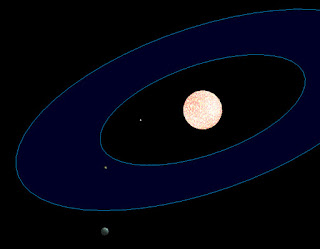I've said several times that it is possible that the human species is the first species in the Milky Way galaxy to evolve to our level of intelligence and technology. This opinion is based on information about just how much needs to happen to allow for the spark of life in conjunction with the apparent rarity of our own solar system. The recent study Relative likelihood for life as a function of cosmic time seems to confirm this idea.
A basic premise is that life requires stars for two different purposes. The study states,
Life is very unlikely to have occurred until Population I stars formed and supported terrestrial planets. Terrestrial planets in the Goldilocks Zone around their star then had to have the necessary events and composition to allow for the spark of life to occur, and subsequently support life until species of higher intelligence evolve.
This could explain why we've not seen evidence of extraterrestrial intelligent life in our galaxy. Maybe we are among the very first. Others like us are so rare, we will not be able to contact each other.

Maybe a billion years from now, a future intelligent species will evolve on some future (yet to exist) world, and when they point radio telescopes into their night sky, they receive a song of hundreds of thousands radio signals from just as many other civilizations. Maybe, if our species is able to continue evolving, our long-from-now-posterity becomes the evil invaders of other worlds, rather than our world being the one constantly invaded, as Hollywood would have us imagine. Maybe we are the monsters in waiting.
Response:
Facebook1 and Facebook2
reddit
A basic premise is that life requires stars for two different purposes. The study states,
Life requires stars for two reasons. Stars are needed to produce the heavy elements (carbon, oxygen and so on, up to iron) out of which rocky planets and the molecules of life are made. Stars also provide a heat source for powering the chemistry of life on the surface of their planets.[001]This means that rogue planets aren't likely to spark or support life. This also means that Population III and most Population II stars systems will not have life either, because they are unlikely to have the elements necessary to form terrestrial planets. That pretty much leaves us with Population I stars.
 |
| Rogue planet, artist concept |
 |
| Population III or II stars, artist concept |
What's all this about "Population"? It's a name for stars at various stages of galaxy development.
- Population III stars are the stars that likely formed right after the Big Bang. They have not been directly observed, so their existed is estimated. They were made up of mostly Hydrogen and Helium. As such, they are unlikely to have any planets.
- Population II stars are stars that are still made up of mostly Hydrogen and Helium, but have higher concentrations of elements such as Oxygen, Silicon, Neon, etc. Typically, such star systems are still unlikely to contain terrestrial planets. Many Population II stars still exist in our galaxy, though in regions without access to many heavier elements.
- Population I stars are stars that are yet again still made up of mostly Hydrogen and Helium, but have much higher concentrations of the more stable element Iron and other heavy elements. Population I star systems are much more likely to contain terrestrial planets. The Sun (Sol) is a Population I star.
Life is very unlikely to have occurred until Population I stars formed and supported terrestrial planets. Terrestrial planets in the Goldilocks Zone around their star then had to have the necessary events and composition to allow for the spark of life to occur, and subsequently support life until species of higher intelligence evolve.
Is Earth ahead of the curve for the development of life?
The previously mentioned study suggests that Earth may have developed life to the human-level a bit earlier than average. The study concludes that, "life around low mass stars in the distant future is much more likely than terrestrial life around the Sun today."[001] Life throughout the galaxy may be far more common billions of years from now than it is today. That also means that there may not be any/many other alien species with which we can contact and interact right now. The study puts our odds at 0.1%.[001]This could explain why we've not seen evidence of extraterrestrial intelligent life in our galaxy. Maybe we are among the very first. Others like us are so rare, we will not be able to contact each other.

Maybe a billion years from now, a future intelligent species will evolve on some future (yet to exist) world, and when they point radio telescopes into their night sky, they receive a song of hundreds of thousands radio signals from just as many other civilizations. Maybe, if our species is able to continue evolving, our long-from-now-posterity becomes the evil invaders of other worlds, rather than our world being the one constantly invaded, as Hollywood would have us imagine. Maybe we are the monsters in waiting.
Response:
Facebook1 and Facebook2
Article Series:
- Limited lifespan of Habitable Zones around other stars [and a loosely held secret finally revealed about me]
- Small stars may have stable Habitable Zones, but habitable planets might not be common there
- Habitable Planets around White Dwarfs
- Habitable Worlds Around Binary Star Systems might not match Sci-fi
- How many Earth-like planets are orbiting Sun-like stars?
- First round of life in the Universe might have been possible extremely early
- Factors a planet needs for suitability of life; perhaps
- "Goldilocks zone of metallicity" on a galactic scale
- Maybe we are the first

















